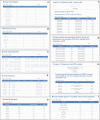COMBATdb: a database for the COVID-19 Multi-Omics Blood ATlas
- PMID: 36353986
- PMCID: PMC9825482
- DOI: 10.1093/nar/gkac1019
COMBATdb: a database for the COVID-19 Multi-Omics Blood ATlas
Abstract
Advances in our understanding of the nature of the immune response to SARS-CoV-2 infection, and how this varies within and between individuals, is important in efforts to develop targeted therapies and precision medicine approaches. Here we present a database for the COvid-19 Multi-omics Blood ATlas (COMBAT) project, COMBATdb (https://db.combat.ox.ac.uk). This enables exploration of multi-modal datasets arising from profiling of patients with different severities of illness admitted to hospital in the first phase of the pandemic in the UK prior to vaccination, compared with community cases, healthy controls, and patients with all-cause sepsis and influenza. These data include whole blood transcriptomics, plasma proteomics, epigenomics, single-cell multi-omics, immune repertoire sequencing, flow and mass cytometry, and cohort metadata. COMBATdb provides access to the processed data in a well-defined framework of samples, cell types and genes/proteins that allows exploration across the assayed modalities, with functionality including browse, search, download, calculation and visualisation via shiny apps. This advances the ability of users to leverage COMBAT datasets to understand the pathogenesis of COVID-19, and the nature of specific and shared features with other infectious diseases.
© The Author(s) 2022. Published by Oxford University Press on behalf of Nucleic Acids Research.
Figures




References
-
- Ginhoux F., Yalin A., Dutertre C.A., Amit I.. Single-cell immunology: past, present, and future. Immunity. 2022; 55:393–404. - PubMed
Publication types
MeSH terms
Grants and funding
LinkOut - more resources
Full Text Sources
Medical
Miscellaneous

